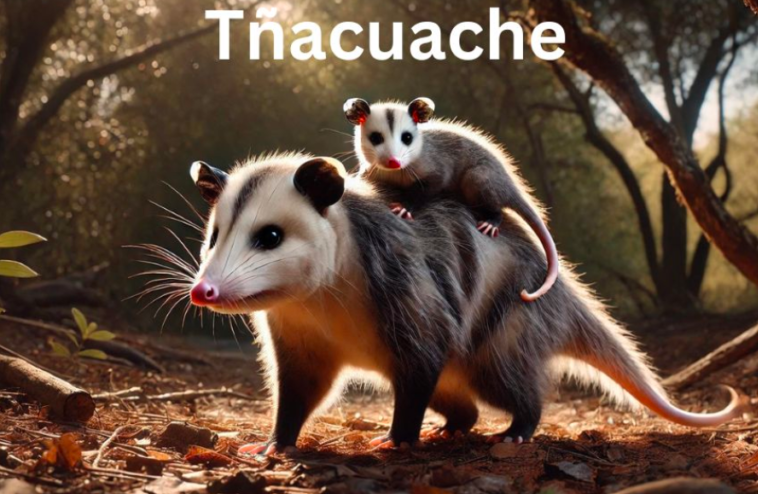Introduction
In the rich tapestry of wildlife across North and South America, the tñacuache (known as the Virginia opossum in English-speaking regions) stands out as a resilient and adaptable creature. This small marsupial, often misunderstood, has evolved to live alongside humans, thriving in both urban and rural environments. Whether scavenging through suburban garbage or foraging in dense forests, the tñacuache plays a crucial role in ecosystems by controlling pests, dispersing seeds, and even cleaning up carrion.
In this article, we’ll delve deep into the world of tñacuaches, exploring their biology, habits, ecological significance, myths, and how we can coexist with them. By the end, you’ll have a fuller appreciation for this often-overlooked yet fascinating creature.
What Is a Tñacuache?
Understanding the Species
The tñacuache, more scientifically known as Didelphis virginiana or the Virginia opossum, is the only marsupial found north of Mexico. Marsupials are unique mammals, best known for their distinctive reproductive system, where females carry their young in a pouch after birth.
These animals have evolved to be highly adaptable, thriving in various environments, including forests, wetlands, and increasingly in urban areas. Tñacuaches are nocturnal and solitary creatures, primarily active at night and relying on their keen sense of smell to find food. While their appearance may seem unsightly to some, these creatures are an essential part of the ecosystem.
Physical Characteristics
Tñacuaches have several distinctive features that make them stand out from other wildlife:
- Size: Typically 2-3 feet long, including the tail.
- Weight: Ranges from 4 to 12 pounds depending on diet and environment.
- Color: Their fur is typically grayish-white, with a white face and black ears.
- Tail: They have a prehensile tail, which they use to grasp and hold onto objects like branches, aiding their tree-climbing abilities.
- Lifespan: In the wild, tñacuaches typically live for 2 to 4 years due to predation, road accidents, and other risks.
A Closer Look at Their Marsupial Traits
One of the key characteristics of tñacuaches, like other marsupials, is their reproductive system. After a very short gestation period (around 12-14 days), the young are born in a premature state and crawl into the mother’s pouch, where they continue to develop. Female tñacuaches can give birth to as many as 20 babies, but only a few typically survive, as the pouch can only accommodate a limited number.
The Habitat of Tñacuaches
Diverse Environments
Tñacuaches are among the most adaptable mammals in the Americas. They can be found in a variety of environments:
- Forests: Especially near rivers and water bodies, where they can find food and shelter.
- Urban Areas: Cities and towns have become prime habitats for tñacuaches. Their scavenging abilities make urban environments an abundant food source.
- Grasslands: Open areas with scattered trees and bushes provide both food and protection.
- Wetlands: Tñacuaches are known to thrive near water bodies, where they can forage for insects, amphibians, and other small creatures.
Adaptability to Human Environments
Tñacuaches have adjusted well to living alongside humans. They are often seen near homes, scavenging through trash, eating pet food, or seeking shelter in attics or garages. While some see them as pests, their role in controlling pests like insects and rodents makes them beneficial in urban ecosystems.
The Diet of Tñacuaches
Omnivorous Diet
Tñacuaches are omnivores, meaning they eat both plant and animal matter. This varied diet allows them to adapt to different environments and food availability. Their diet includes:
- Fruits and Vegetables: They eat a wide variety of fruits, berries, and vegetables, depending on seasonal availability.
- Insects and Invertebrates: Beetles, crickets, and other insects form a significant portion of their diet, helping to control pest populations.
- Small Animals: Tñacuaches will eat small rodents, birds, and even amphibians.
- Carrion: As scavengers, they play an important role in cleaning up dead animals from their environment.
- Human Food Waste: In urban areas, tñacuaches are known to forage through garbage, eating leftovers and scraps.
Table: Sample Tñacuache Diet
| Category | Examples |
| Fruits | Berries, apples, bananas, melons |
| Vegetables | Corn, tomatoes, leafy greens |
| Insects | Beetles, crickets, cockroaches |
| Small Animals | Mice, baby birds, frogs |
| Carrion | Roadkill, dead wildlife |
| Human Waste | Leftovers, pet food, discarded scraps |
The Ecological Role of Tñacuaches
Pest Control
Tñacuaches play an essential role in controlling pest populations. Their diet includes many creatures that are considered pests by humans, such as insects and rodents. By consuming these pests, tñacuaches help reduce the spread of diseases carried by these animals. For example, they eat ticks, which can carry Lyme disease. Some studies suggest that a single tñacuache can consume thousands of ticks in a season.
Seed Dispersal
As they consume fruits and vegetables, tñacuaches inadvertently help in seed dispersal. They eat fruits and later excrete the seeds, often far from the original plant. This natural process aids in the spread of various plant species, promoting biodiversity.
Scavenging and Cleaning Up Ecosystems
One of the most overlooked but critical roles tñacuaches play is as scavengers. By consuming carrion (dead animals), they help clean up the environment and prevent the spread of diseases associated with decaying bodies. This scavenging habit also puts them in a unique position to reduce food waste in both natural and urban environments.
Myths and Misunderstandings About Tñacuaches
Despite their beneficial roles in the ecosystem, tñacuaches are often misunderstood. Let’s debunk some of the most common myths surrounding them.
Myth 1: Tñacuaches Are Aggressive
One of the most prevalent myths about tñacuaches is that they are aggressive and will attack humans. In reality, tñacuaches are shy and prefer to avoid confrontation. When threatened, they may bare their teeth or hiss, but this is a defensive tactic. They are more likely to “play dead” than to fight.
Myth 2: They Carry Rabies
Another common misconception is that tñacuaches frequently carry rabies. While all mammals can theoretically contract rabies, tñacuaches have a lower body temperature than most mammals, making it difficult for the rabies virus to survive in their system. Instances of rabies in tñacuaches are extremely rare.
Myth 3: They Are Dirty and Disease-Ridden
Tñacuaches are often considered dirty animals because of their scavenging habits. However, their immune system is incredibly robust. They are resistant to certain types of snake venom and are less likely to carry diseases like rabies compared to other wildlife.
Fun Facts About Tñacuaches
- “Playing Possum”: Tñacuaches are known for their unique defense mechanism called “playing possum,” where they feign death to avoid predators. This involuntary response can last anywhere from a few minutes to several hours.
- Prehensile Tail: Their tails can be used to grip branches and other objects, helping them climb trees and move around their environment with ease.
- Immunity to Snake Venom: Tñacuaches have a natural resistance to the venom of certain snakes, such as rattlesnakes. This gives them a unique advantage in the wild.
- Low Body Temperature: With a body temperature of about 94–97 degrees Fahrenheit, tñacuaches are less susceptible to many diseases that affect other mammals.
Challenges Facing Tñacuaches
Despite their adaptability, tñacuaches face several challenges in today’s world. Human activity, in particular, poses a significant threat to their survival.
Habitat Loss
Urbanization and deforestation are two of the biggest threats to tñacuache populations. As more land is cleared for development, tñacuaches lose their natural habitats, forcing them to live closer to human populations, which can lead to conflict.
Road Mortality
One of the most common causes of death for tñacuaches is road accidents. Being nocturnal, tñacuaches often venture out at night in search of food, and many are hit by cars as a result. This is especially common in urban and suburban areas, where roads cut through their natural habitats.
Perception as Pests
In many urban areas, tñacuaches are seen as pests. People often set traps or use poisons to remove them from their properties, which can be harmful not only to tñacuaches but also to the local ecosystem. This negative perception contributes to the decline of tñacuache populations in some areas.
How to Coexist with Tñacuaches
Given the essential role they play in ecosystems, it’s important to find ways to coexist with tñacuaches rather than eliminate them. Here are some practical tips for living alongside these creatures:
- Secure Trash Bins: To avoid attracting tñacuaches to your home, make sure your trash bins are sealed tightly. This will reduce the likelihood of them scavenging through your garbage.
- Remove Food Sources: If you feed pets outdoors, bring the food indoors at night to prevent tñacuaches from eating it.
- Seal Entry Points: Tñacuaches may seek shelter in attics or garages. Make sure any entry points to your home are sealed to prevent them from getting inside.
- Humane Deterrents: If you find a tñacuache in your yard, use humane deterrents like motion-activated lights or sprinklers to encourage them to move on without harming them.
Table: Ways to Coexist with Tñacuaches
Problem |
Solution |
| Trash Scavenging | Secure trash bins with tight-fitting lids |
| Pet Food Theft | Bring pet food indoors after feeding |
| Shelter Seeking | Seal entry points to homes and garages |
| Overpopulation | Use humane traps or deterrents |
Conclusion
The tñacuache, or Virginia opossum, is a remarkable creature that has adapted to survive in a wide variety of environments. Despite being misunderstood and often maligned, these animals play a crucial role in maintaining the balance of ecosystems. From pest control to seed dispersal and scavenging, tñacuaches are unsung heroes of nature.
By debunking myths and learning how to coexist with tñacuaches, we can better appreciate the role they play in our world. Whether you encounter one in your backyard or see one scurrying across the street at night, remember that these resilient creatures are simply trying to survive in an ever-changing world, just like us.
Frequently Asked Questions (FAQs)
What is a tñacuache?
The tñacuache, also known as the Virginia opossum, is a marsupial native to North America, known for its adaptability and scavenging habits.
What do tñacuaches eat?
Tñacuaches are omnivores, feeding on fruits, insects, small animals, and carrion. They also scavenge human food waste in urban areas.
Are tñacuaches dangerous?
No, tñacuaches are not aggressive. They are shy, and when threatened, they may play dead to avoid confrontation rather than attack.
Do tñacuaches carry rabies?
Tñacuaches rarely carry rabies due to their low body temperature, which makes it difficult for the virus to thrive in their system.
How can I keep tñacuaches away from my home?
To prevent tñacuaches from visiting, secure trash bins, remove outdoor pet food, and seal any potential entry points to your home.






